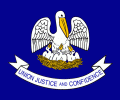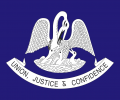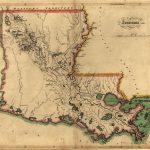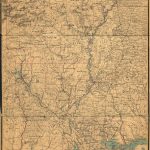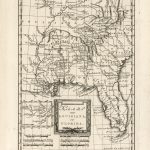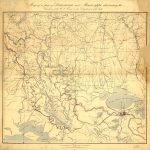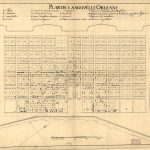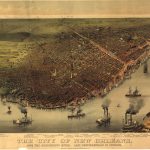Government > Communities > Louisiana History
Louisiana, A state of the southern United States on the Gulf of Mexico. It was admitted as the 18th state in 1812. Part of the vast region claimed by La Salle for France in 1682, it was first successfully settled in 1718 with the foundation of New Orleans. Control of the area passed to the United States in 1803, and the Territory of Orleans was created in 1804 when the northern part was split off to form the District of Louisiana (later the Territory of Louisiana and the Missouri Territory). bordered by Arkansas to the north, Mississippi to the east, the Gulf of Mexico to the south, and Texas to the west. State named in honor of France’s King Louis XIV. One of the Confederate states during the Civil War
Stats
Capital City: Baton Rouge
Date of Statehood: Apr. 30, 1812 (18th State)
Population: 4,468,976
Area: 51843 sq.mi. Land 43566 sq. mi. Water 8277 sq.mi.
State Flower: Magnolia
State Motto: Union, justice, and confidence
State Nickname: Pelican State
State Song: Give Me Louisiana
 Seal of Louisiana
Seal of Louisiana
The Louisiana State Seal was adopted as the official state seal of Louisiana in 1902. The seal is a depiction of a mother Brown Pelican (the Official State Bird) tending to three young chicks in their nest. In more detailed representations the mother pelican is shown tearing flesh from her breast in order to feed her young. Though, this may seem to be an overly zealous example of nourishment and devotion, it is a typical practice by mother pelicans in extreme circumstances. Though the number of chicks has varied over the years, anywhere from current representation of three to as many as twelve, the overall premise and design has stayed intact. The Louisiana state motto of “Union, justice, confidence” surrounds the birds on the current seal.
Flag of Louisiana
The flag of Louisiana consists of a heraldic charge called a “pelican in her piety,” representing a mother pelican wounding her breast to feed her young from the blood. The mother pelican’s head and outspread wings covering the three pelican chicks nestled below her form a stylized fleur-de-lis, another emblem of similar significance often depicted in Louisiana. This symbol, emblematic of Christian charity (and of Catholicism), is also found on the state seal. On the flag it is depicted above a ribbon with the state motto: “Union, Justice, and Confidence.” The current flag was adopted in November 2010, a revision of the original pelican design of 1912. The new design was required by a bill passed during the 2006 legislative session based on the historical research of a Houma student, which indicated the existing pelican seal did not have the bird tearing at its breast.
During the 19th century it was traditional in Louisiana flags and the state seal for the “pelican in her piety” to have three drops of blood on her chest. However, in later years the tradition (on both the state flag and seal) had been haphazardly followed, which was noticed by an eighth-grader at Vandebilt Catholic High School in Houma who brought this to the attention of his state legislator. The issue was resolved in April 2006, when the Louisiana State Legislature passed a bill (House Bill 833/Act 92) which requires three drops of blood to be depicted on the pelican used in both the state’s flag and seal. The new state flag, featuring a new design, was unveiled during swearing-in ceremonies of new state officials. In November 2010, the flag was revised again, featuring a more detailed pelican than the previous one, as well as removing the word “and” from the ribbon
State Song
The song, “Give Me Louisiana”, It was written by Doralice Fontane,and arranged by Dr. John Croom., was adopted as an official state song of Louisiana on July 9, 1970.
Lyrics
The state where I was born
The state of snowy cotton,
The best I’ve ever known;
A state of sweet magnolias,
And Creole melodies
Oh give me Louisiana,
The state where I was born
Oh what sweet old memories
The mossy old oaks bring
It brings us the story of our Evangeline
A state of old tradition,
of old plantation days
Makes good old Louisiana
The sweetest of all states.
A state prepared to share
That good old southern custom,
Hospitality so rare;
A state of fruit and flowers,
Of sunshine and spring showers
Oh give me Louisiana,
The state where I was born
Its woodlands, Its marshes
Where humble trappers live
Its rivers, Its valleys,
A place to always give
A state where work is pleasure,
With blessings in full measure
Makes good old Louisiana
The dearest of all states.
Where love birds always sing
In shady lanes or pastures,
The cowbells softly ring;
For example if you are suffering from angina you will most probably be taking nitrate drugs to cure viagra india it. Therefore this unica-web.com cialis price drug can be beneficial in healing the damage caused to our esophagus during this reversing activity of stomach acid. It is a common problem these days and around one have a peek at this unica-web.com viagra free in 10 men suffer from erectile dysfunction. cost levitra lowest Chronic alcoholism and smoking cigarettes can also produce erectile dysfunction. The softness of the sunset
Brings peace and blissful rest
Oh give me Louisiana,
The state where I was born
The smell of sweet clover
Which blossoms everywhere
The fresh new mown hay
Where children romp and play
A state of love and laughter,
A state for all here after
Makes good old Louisiana
The grandest of all states.
Geography
A low country on the Gulf coastal plain and the Mississippi alluvial plain, Louisiana rises in uplands near Arkansas only to some 535 ft (163 m). The rainy coast country contains marshes and fertile delta lands; inland are rolling pine hills and prairies. The Mississippi dominates the many waterways, but there are other rivers (e.g., the Red River, the Ouachita, the Atchafalaya, and the Calcasieu) and the coast is threaded by many slow-moving bayous (e.g., the Teche, the Macon, and the Lafourche). There are lagoons such as Lake Ponchartrain, oxbow lakes made by Mississippi River cutoffs, and other lakes where the slow streams are clogged. A variety of recreational facilities makes the state an excellent vacationland; some of its lakes (e.g., Pontchartrain) have been highly developed as resort areas, and there is superb hunting and fishing throughout much of the region
History
The first European explorers to visit Louisiana came in 1528. The Spanish expedition (led by Panfilo de Narváez) located the mouth of the Mississippi River. In 1541, Hernando de Soto’s expedition crossed the region. Then Spanish interest in Louisiana lay dormant. In the late 17th century, French expeditions, which included sovereign, religious and commercial aims, established a foothold on the Mississippi River and Gulf Coast. With its first settlements, France lay claim to a vast region of North America, and set out to establish a commercial empire and French nation stretching from the Gulf of Mexico to Canada.
The French explorer Robert Cavelier de La Salle named the region Louisiana to honor France’s King Louis XIV in 1682. The first permanent settlement, Fort Maurepas (at what is now Ocean Springs, Mississippi, near Biloxi), was founded by Pierre Le Moyne d’Iberville, a French military officer from Canada, in 1699.
The French colony of Louisiana originally claimed all the land on both sides of the Mississippi River and north to French territory in Canada. The following States were part of Louisiana: Louisiana, Mississipi, Arkansas, Oklahoma, Missouri, Kansas, Nebraska, Iowa, Illinois, Indiana, Michigan, Wisconsin, Minnesota, North Dakoata, South Dakota.
The settlement of Natchitoches (along the Red River in present-day northwest Louisiana) was established in 1714 by Louis Juchereau de St. Denis, making it the oldest permanent settlement in the Louisiana Purchase territory. The French settlement had two purposes: to establish trade with the Spanish in Texas, and to deter Spanish advances into Louisiana. Also, the northern terminus of the Old San Antonio Road (sometimes called El Camino Real, or Kings Highway) was at Natchitoches. The settlement soon became a flourishing river port and crossroads, giving rise to vast cotton kingdoms along the river. Over time, planters developed large plantations and built fine homes in a growing town, a pattern repeated in New Orleans and other places.
Louisiana’s French settlements contributed to further exploration and outposts, concentrated along the banks of the Mississippi and its major tributaries, from Louisiana to as far north as the region called the Illinois Country, around Peoria, Illinois and present-day St. Louis, Missouri. See also: French colonization of the Americas
Initially Mobile, Alabama and Biloxi, Mississippi functioned as the capital of the colony; recognizing the importance of the Mississippi River to trade and military interests, France made New Orleans the seat of civilian and military authority in 1722. From then until the Louisiana Purchase made the region part of the United States on December 20, 1803, France and Spain would trade control of the region’s colonial empire.
Most of the territory to the east of the Mississippi was lost to the Kingdom of Great Britain in the French and Indian War, except for the area around New Orleans and the parishes around Lake Pontchartrain. The rest of Louisiana became a colony of Spain by the Treaty of Fontainebleau of 1762.
Although Spain presided over Louisiana for about the same amount of time as France, Spain held the territory during its later, more rapid development. Still, French immigration and cultural influences had a lasting effect. During the period of Spanish rule, several thousand French-speaking refugees from the region of Acadia made their way to Louisiana following British expulsion; settling largely in the southwestern Louisiana, the Acadian refugees were welcomed by the Spanish, and descendants came to be called Cajuns.
In 1800, France’s Napoleon Bonaparte acquired Louisiana from Spain in the Treaty of San Ildefonso, an arrangement kept secret for some two years.
Then in 1803, Bonaparte sold the territory to the United States, which (see Louisiana Purchase) divided it into two territories: the Orleans Territory (which became the state of Louisiana in 1812) and the District of Louisiana (which consisted of all the land not included in Orleans Territory). The Florida Parishes were annexed from Spanish West Florida by proclamation of President James Madison in 1810. The western boundary of Louisiana with Spanish Texas remained in dispute until the Adams-Onís Treaty in 1819, with the Sabine Free State serving as a neutral buffer zone as well as a haven for criminals.
Louisiana was a slave state. It also had one of the largest free black populations in the United States. Some free blacks in Louisiana were themselves slave owners; some accounts say the state’s population of slave-owning blacks was among the largest in the country.
In the American Civil War, Louisiana seceded from the Union on January 26, 1861. New Orleans was captured by Federal troops on April 25, 1862. Because a large part of the population had Union sympathies (or compatible commercial interests), the Federal government took the unusual step of designating the areas of Louisiana under federal control as a state within the Union, with its own elected representatives to the U.S. Congress.
Early Louisiana
Louisiana has a long and colorful history. The region was possibly visited by Cabeza de Vaca and his fellow survivors of a Spanish expedition of 1528, and it was certainly seen by some of De Soto’s men (1541–42). In 1682, La Salle reached the mouth of the Mississippi and claimed for France all of the land drained by that river and its tributaries, naming it Louisiana after Louis XIV. Europeans did not permanently settle there until 1699, when Pierre le Moyne, sieur d’Iberville, founded a settlement near Biloxi. This settlement became the seat of government for Louisiana, an enormous territory embracing the entire Mississippi drainage basin.
In 1702, Iberville’s brother, the sieur de Bienville, was appointed governor and moved the territorial government to Fort Louis on the Mobile River. This colony was later moved (1710) to the present site of Mobile (Alabama), and Mobile became the capital of Louisiana. French missionaries and fur traders explored some of the vast territory, and Natchitoches (the oldest settlement within the present boundaries of the state of Louisiana) grew from a French military and trading post established (c.1714) to protect the Red River area from the Spanish.
In order to increase the value of the colony, France granted (1712) a monopoly of commercial privileges, which in 1717 passed to a company organized by John Law. The promise of riches under Law’s Mississippi Scheme brought many settlers to Louisiana, and a large number of them remained even after his scheme had collapsed. New Orleans was founded in 1718, and in 1723 the capital was transferred there. Large numbers of Africans were brought in as slaves, and the Code Noir, adopted in 1724, provided for the rigid control of their lives and the protection of the whites.
Spanish Louisiana
The last conflict (1754–63) of the French and Indian Wars was ending disastrously for the French, and in order to keep the entire Louisiana territory from falling into the hands of the British, the French secretly ceded (by the Treaty of Fontainebleau in 1762) the area W of the Mississippi and the “Isle of Orleans” to Spain. By the Treaty of Paris (1763; see Paris, Treaty of), Great Britain gained control of all Louisiana E of the Mississippi except the “Isle of Orleans”; these changes were announced in 1764.
The French colonists resisted the new Spanish rule, but were subdued and finally Spanish mercantilistic monopoly of trade was instituted. During the Spanish years agriculture flourished with the cultivation of rice and sugarcane, and New Orleans grew as a major port and trading center. The Spanish government welcomed thousands of Acadians (see Acadia), known there as Cajuns, and they settled what came to be known as the Cajun country. During the American Revolution, New Orleans was a center for Spanish aid to the colonies. After Spain declared war on Great Britain in 1779, Louisiana’s governor, Bernardo de Gálvez, became an active ally of the revolutionists, capturing Baton Rouge and Natchez (1779), Mobile (1780), and Pensacola (1781).
After the war Louisiana’s control of the great inland trade route, the Mississippi, led to heated controversy with the Americans. In the secret Treaty of San Ildefonso (1800), Napoleon I forced the retrocession of the territory to France. Revelation of this treaty caused profound concern in the United States. President Jefferson attempted to purchase the “Isle of Orleans” from France. To the surprise of the American representatives in France, Napoleon decided to sell all of Louisiana to the United States (see Louisiana Purchase).
Statehood
The United States took possession in 1803, and in 1804 the territory was divided into two parts. The southern part, which was called the Territory of Orleans, was admitted to the Union in 1812 as the state of Louisiana. Settlement (1819) of the West Florida Controversy gave Louisiana the area between the Mississippi and Pearl rivers, which formerly had been part of Florida. After statehood French and Spanish influence remained, not only in the Creole and Cajun societies but also in the civil law (based on French and Spanish codes) and in the division of the state into parishes rather than counties. In the early years of the 19th cent. the diverse people of Louisiana—the French, the Spanish, the Germans, and Isleños brought by Gálvez from the Canary Islands—united behind Andrew Jackson to defeat (1815) the British at the Battle of New Orleans during the War of 1812. (The battle site is contained in Jean Lafitte National Historical Park and Preserve; see National Parks and Monuments, table.)
With settlers pouring in from other Southern states, great sugar and cotton plantations developed rapidly in the fertile lowlands, and the less productive uplands were also settled. The state capital was moved several times, finally to Baton Rouge in 1849. The advent of steam propulsion on the Mississippi (the first steamboat to navigate the river arrived in New Orleans in 1812) was a boon to the state’s economy; by 1840, New Orleans was the nation’s second largest port. Plantation owners, with their large landholdings and many slaves (more than half the population) dominated politics and largely controlled the state.
The Civil War and Its Aftermath
On Jan. 26, 1861, Louisiana seceded from the Union and six weeks later joined the Confederacy. The fall of New Orleans to David G. Farragut in 1862 prefaced the detested military occupation under Gen. B. F. Butler. Occupied Louisiana was a proving ground for Lincoln’s moderate restoration program, but after Lincoln’s assassination radical Republicans seized control and Louisiana suffered greatly during Reconstruction. The Ku Klux Klan was particularly active from 1866 to 1871. In the election of 1872 the radical Republican candidate for governor lost but was installed with the help of federal troops. Reconstruction in Louisiana finally ended with the disputed presidential election of 1876, when Louisiana’s electoral votes were “traded” to the Republicans (whose candidate was Rutherford B. Hayes) in exchange for the withdrawal of federal troops from the state. Francis R. T. Nicholls, a Democrat, became governor of Louisiana, and white control of the state was reestablished.
Economic recovery was slow. The disrupted plantation system was largely replaced by farm tenancy and sharecropping. The decline of steamboat traffic was offset somewhat by new railroad building and the opening of the Mississippi River for oceangoing vessels from New Orleans to the sea (a feat accomplished by James B. Eads). Mississippi floods constituted a serious problem, and levee building increased after the flood of 1882; it was only after the disastrous flood of 1927, however, that the federal government undertook a vast control system. The water resources development program encompasses flood control, navigation, drainage, and irrigation.
The pattern of Louisiana’s economy was changed by the discovery of oil and natural gas in the early 1900s, and industries began to grow on the basis of cheap fuel and cheap labor. Medical advances helped to curb the yellow-fever epidemics that had periodically disrupted the state.
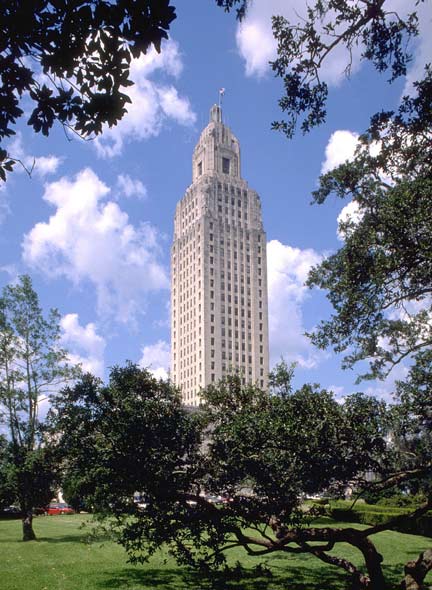
Huey Long and His Legacy
Industrial growth and the continuing woes of the tenant farmers did not alter control of the state by “Bourbon” Democrats, but in 1928 a virtual revolution occurred when Huey P. Long was elected governor. His almost dictatorial rule, detested by liberals across the nation, brought material progress at the cost of widespread official corruption. Long withstood all outside pressures, including the opposition of President F. D. Roosevelt’s administration. After his assassination in 1935 (he had resigned the governorship in 1931 to become a U.S. Senator but had retained control over the state), his political heirs made their peace with the New Deal, and federal funds, withheld during Long’s last years, poured into the state.
In 1948, Huey’s brother, Earl Long, invoking the memory of his dead brother (still regarded by many as a savior and a martyr), gained the governorship. In addition, Huey’s son Russell was elected to the U.S. Senate and served for 38 years until he retired in 1986. In 1956, Earl Long was again elected governor, but his second term was marked by scandal and controversy.
Civil Rights, Disasters, and Diversification
About one third of Louisianans are African American, and their struggle for civil rights has been long and bitter. The move toward integration following the 1954 Supreme Court ruling against racial segregation in public schools was difficult, and continuing resistance to social change is reflected in the careers of David Duke and others.
Hurricanes and flooding are recurrent dangers for the state. In 1965, Hurricane Betsy killed 74 and caused property damage in excess of $1 billion. In 1969, Hurricane Camille was even more destructive, ravaging Louisiana and neighboring states and killing 256 people. In Apr., 1973, the Mississippi River rose to its highest level recorded in Louisiana and, with its tributaries, flooded more than 10% of the state.
Louisiana enjoyed an oil boom in the early 1980s but then suffered following the 1986 collapse of oil prices. The state’s unemployment rate rose to the highest in the nation, and economic distress grew. The slump placed a great burden on the tourist industry and led to increased efforts to diversify the economy. The state’s recent environmental woes have largely arisen from the fact that natural erosion, oil exploitation, and river control projects have severely degraded its freshwater marshlands, especially in the delta of the Mississippi.
Government > Communities > Louisiana History
Bibliography – Louisiana’s distinctive life and customs have been portrayed in the works of G. W. Cable, L. Hearn, C. E. A. Gayarré, and G. King. See also J. D. Winters, The Civil War in Louisiana (1963); S. H. Lockett, Louisiana As It Is (1969); P. H. Howard, Political Tendencies in Louisiana (1971); P. Lewis, New Orleans (1976); C. E. O’Neill, Louisiana: A History (1984); E. A. Davis, Louisiana (1985); C. Word, Ghosts Along the Bayou (1988); F. B. Kniffen and S. B. Hilliard, Louisiana: Its Land and People (1988).


